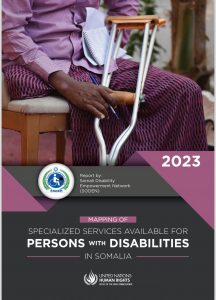Any mention of Somalia conjures up images of war. Yet hidden from international glare is a huge disease burden that keeps the Federal Government anxious for solutions. Following decades of war, the national health infrastructure disintegrated to a level where basic health care systems ground to a halt.
According to World Health Organization (WHO), lower respiratory infections is still the leading cause of deaths in Somalia, followed by diarrhoeal diseases, measles, malnutrition, tuberculosis, meningitis and maternal conditions.
Statistics about Somalia’s health status is scanty. WHO 2013 figures estimate under-five mortality rate in Somalia, at 146 deaths per every 1,000 births and maternal mortality rate at 850 deaths, for every 100,000 live births.
This means that Somalia has fallen short of meeting the Millennium Development Goals(MDGs), whose deadline is June 2015, by a big margin. A reports by UNDP describes Somalia’s situation as “seriously off track”, with only one out of eight targets likely to be met.
The report concludes that, “There is insufficient data to plot progress of Somalia’s MDGs, but the country is predicted to be seriously off track in meeting them. With the current political instability it is unlikely that Somalia will reverse this pattern in the near future.”
Grim as it may be, the report is an outcome of a capacity building workshop for MDGs, held in Kampala, Uganda in 2010.
Somalia’s Director of Policy Planning and Coordination in the Ministry of Health Dr. Abdi Hamid Ibrahim concurs with this report. He says, “The health report of the country is very bad. I think it is the second worst in the world but this is because of a number of the numerous and endless conflicts, social unrest and famine that the country has faced which have led to the total collapse of infrastructure.”
The situation is compounded by limited resources, but there is a ray of hope. Dr. Ibrahim says plans are underway by the government to reverse the downward trend.
“Together with other partners such as WHO, UNICEF and UNFPA we are trying to revamp the country’s health system,” says Dr. Ibrahim. He adds that to date, the government has so far managed to draft a national health policy, promising that more key health documents are in the offing, even as he concedes that the task before the government is huge.
On the surface, respiratory infections and childhood diseases such as malnutrition, seem like the only hurdle Somalia needs to jump. However, statistics from the world health body, WHO, also shows a significant rise in suicide, homicide and conflict related deaths in Somalia since 2012, indicative of increased mental disorder. With the war almost gone, a new challenge stares Somalia in the face: mental illness.
This illness pervades the country and victims are a common sight. Yet only six nurses in the entire country have been trained in mental health care, according to another report by the World Health Organisation on the assessment of mental health systems in South and Central Somalia.
The Assessment Instrument for Mental Health Systems (AIMS) paints another grim picture of mental health, in a country still on the path to stabilisation.
The genesis of mental illness in Somalia is hinged on years of violence, civil strife and chaos that characterized the country in the past. Somalia is rated to have one of the highest mental illness rates, with one out of three people afflicted, according to WHO. Figures could even be much higher, given the widely held belief in superstition and the unavailability of data.
Because of its debilitating effects, mental illness remains a taboo in Somali society, there’s a spiral of silence about it, with mentally sick people either isolated, chained or kept in extreme situations. For those lucky to find help, essential psychotropic medicines are hard to come by, and many depend on people of good will, to keep the supply of medicines flowing.
For a country emerging out of war, Somalia’s mental health problem is a conspiracy of factors — a rundown health care system, lack of a mental health care policy and legislation, no budgetary allocation for mental illness and a laissez faire attitude towards the problem by other stakeholders. This calls for quick intervention.
With no qualified psychiatrists and a dismal number of nurses, some equipped with as much as three months training in mental health, providing care to a population of about 10 million is a daunting task.
Abdirahman Ali Awale, fondly known as Dr. Habeb is a mental health practitioner. He is a man who has dedicated his life to helping Somalia’s mentally ill and runs a chain of mental private clinics across the country.
In these clinics — five in Mogadishu and others up country — he treats tens of mentally ill patients. Most mental illness patients in the country suffer from Post-Traumatic Stress Disorder (PTSD). Others suffer from depression or schizophrenia.
And it is not that nothing is being done. Aware of the problem, AMISOM early this year identified the Community Health Care Centre in Baidoa as a needy institution, and donated an assortment of items, including medicines.
Despite a myriad of Non- Governmental Organizations (NGOs) operating in the country, none of them is involved with mental illness, preferring to deal with communicable diseases. “Mental illness is one of the non- communicable diseases and it is killing more patients than before due to an increase in a number of social issues,” states Dr. Ibrahim.
He adds, “It is a big challenge but we have already developed the mental health policy and we are beginning to train some nurses in mental health care but the problem is that no organizations are willing to support us in this area.”
Resource AMISOM








